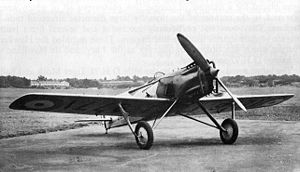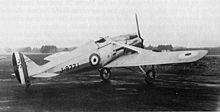- de Havilland DH.77
-
DH.77 Role Interceptor fighter National origin United Kingdom Manufacturer de Havilland Designer W.G Carter First flight 11 July 1929 Status Prototype Number built 1 The de Havilland DH.77 was a prototype British fighter aircraft of the late 1920s. Intended as a fast climbing interceptor for Britain's Royal Air Force, the DH.77 was a lightweight low-wing monoplane powered by a relatively low power engine. Despite excellent performance, only one aircraft was built, the Hawker Fury biplane being preferred.
Contents
Development and design
In 1927, the British Air Ministry, faced with the need to deal with increased bomber performance, issued Specification F.20/27 for a single seat interceptor.[1] Unlike previous fighter Specifications, the resulting aircraft were intended to be short ranged (not intended to mount standing patrols), fast climbing high altitude aircraft, carrying a minimum of equipment.[2] To meet this requirement, de Havilland developed as a Private Venture[3] the DH.77, designed by W.G. Carter, of Gloster Aircraft Company,[a] in close collaboration with engine designer Frank Halford.[4]
The DH.77 was a small low-winged lightweight monoplane, of mixed metal and wood construction, powered by a 300 hp (224 kW) Napier Rapier air-cooled H-engine, which offered very low frontal area to minimise drag. The wing was braced with distinctive bracing struts above the wing, while the aircraft had a wide track fixed tailwheel undercarriage. It was fitted with large span ailerons and a stabilator to give good control characteristics and spin recovery. Armament was the normal pair of synchronised Vickers machine guns, mounted on each side of the cockpit.[5][4]
The single prototype first flew on 11 July 1929.[5] Despite the low power of the Rapier (which gave only 60% of the power of the Rolls-Royce Kestrel which powered the competing Hawker Hornet), the DH.77 demonstrated excellent performance, reaching 204 mph (328 km/h) (although performance carrying a full military load was less, reaching 185 mph (298 km/h)). It was delivered to Martlesham Heath for evaluation by the Aeroplane and Armament Experimental Establishment on 12 December 1929. Although the prototype was purchased by the Air Ministry, no production followed, the orders going to the heavier and more powerful Hawker Fury, production version of the Hornet.[5][6] The DH.77 continued in use at Martlesham until 1934.[7]
Specifications
Data from De Havilland Aircraft since 1909 [7]
General characteristics
- Crew: 1
- Length: 24 ft 4¾ in (7.44 m)
- Wingspan: 32 ft 2 in (9.81 m)
- Height: 8 ft 0 in (2.44 m)
- Wing area: 163 ft² (15.1 m²)
- Empty weight: 1,655 lb (752 kg)
- Loaded weight: 2,279 lb (1,036 kg)
- Powerplant: 1 × Napier Rapier I 16-cylinder air-cooled H engine, 300 hp (224 kW)
Performance
- Maximum speed: 204 mph (177 knots, 328 km/h) at 10,000 ft (3,050 m)
- Service ceiling: 25,900 ft[4] (7,900 m)
- Rate of climb: 1,885 ft/min (9.6 m/s)
Armament
- Guns: 2× .303 in Vickers machine guns
See also
- Aircraft of comparable role, configuration and era
- Bristol Bullpup
- Fairey Firefly II
- Hawker Fury
- Gloster Gauntlet
- Saunders A.10
- Vickers Jockey
- Westland Interceptor
Notes
- a There was an agreement between de Havilland and Gloster to co-operate on the development of de Havilland military aircraft.
References
- Jackson, A.J. De Havilland Aircraft since 1909. London:Putnam, Third edition, 1987. ISBN 0-85177-802-X.
- Lewis, Peter. The British Fighter since 1912. London:Putnam, Fourth edition, 1979. ISBN 0-370-10049-2.
- Mason, Francis K. The British Fighter since 1912.Annapolis, Maryland USA:Naval Institute Press, 1992. ISBN 1-55750-082-7.
de Havilland and Airco aircraft By manufacturer
designationBiplane No.1 · Biplane No.2
DH.1 · DH.2 · DH.3 · DH.4 · DH.5 · DH.6 · DH.9 / DH.9A / DH.9C · DH.10 · DH.11 · DH.12 · DH.14 · DH.15 · DH.16 · DH.17 · DH.18 · DH.19 · DH.20 · DH.21 · DH.22 · DH.23 · DH.24 · DH.25 · DH.26 · DH.27 · DH.28 · DH.29 · DH.30 · DH.31 · DH.32 · DH.33 · DH.34 · DH.35 · DH.36 · DH.37 · DH.38 · DH.39 · DH.40 · DH.41 · DH.42 · DH.43 · DH.44 · DH.45 · DH.46 · DH.47 · DH.48 · DH.49 · DH.50 · DH.51 · DH.52 · DH.53 · DH.54 · DH.55 · DH.56 · DH.57 · DH.58 · DH.59 · DH.60 · DH.61 · DH.62 · DH.63 · DH.64 · DH.65 · DH.66 · DH.67 · DH.68 · DH.69 · DH.70 · DH.71 · DH.72 · DH.73 · DH.74 · DH.75 · DH.76 · DH.77 · DH.78 · DH.79 · DH.80 · DH.81 · DH.82 · DH.83 · DH.84 · DH.85 · DH.86 · DH.87 · DH.88 · DH.89 · DH.90 · DH.91 · DH.92 · DH.93 · DH.94 · DH.95 · DH.96 · DH.97 · DH.98 · DH.99 · DH.100 · DH.101 · DH.102 · DH.103 · DH.104 · DH.105 · DH.106 · DH.107 · DH.108 · DH.109 · DH.110 · DH.111 · DH.112 · DH.113 · DH.114 · DH.115 · DH.116 · DH.117 · DH.118 · DH.119 · DH.120 · DH.121 · DH.122 · DH.123 · DH.124 · DH.125 · DH.126 · DH.127 · DH.128 · DH.129 · DH.130By role FightersBombersPassengerSportsDH.51 · Hawk Moth · Humming Bird · Moth · Puss Moth · Leopard Moth · Hornet Moth
TrainersTiger Moth · Don · Moth Minor
RacersTechnical School Lists relating to aviation General Aircraft (manufacturers) · Aircraft engines (manufacturers) · Airlines (defunct) · Airports · Civil authorities · Museums · Registration prefixes · Rotorcraft (manufacturers) · TimelineMilitary Accidents/incidents Records Categories:- British fighter aircraft 1920–1929
- De Havilland aircraft
Wikimedia Foundation. 2010.


